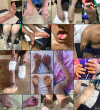Genetic landscape of congenital insensitivity to pain and hereditary sensory and autonomic neuropathies
- PMID: 37769650
- PMCID: PMC10689924
- DOI: 10.1093/brain/awad328
Genetic landscape of congenital insensitivity to pain and hereditary sensory and autonomic neuropathies
Abstract
Congenital insensitivity to pain (CIP) and hereditary sensory and autonomic neuropathies (HSAN) are clinically and genetically heterogeneous disorders exclusively or predominantly affecting the sensory and autonomic neurons. Due to the rarity of the diseases and findings based mainly on single case reports or small case series, knowledge about these disorders is limited. Here, we describe the molecular workup of a large international cohort of CIP/HSAN patients including patients from normally under-represented countries. We identify 80 previously unreported pathogenic or likely pathogenic variants in a total of 73 families in the >20 known CIP/HSAN-associated genes. The data expand the spectrum of disease-relevant alterations in CIP/HSAN, including novel variants in previously rarely recognized entities such as ATL3-, FLVCR1- and NGF-associated neuropathies and previously under-recognized mutation types such as larger deletions. In silico predictions, heterologous expression studies, segregation analyses and metabolic tests helped to overcome limitations of current variant classification schemes that often fail to categorize a variant as disease-related or benign. The study sheds light on the genetic causes and disease-relevant changes within individual genes in CIP/HSAN. This is becoming increasingly important with emerging clinical trials investigating subtype or gene-specific treatment strategies.
Keywords: CIP; HSAN; HSN; genetics; neuropathies; pain.
© The Author(s) 2023. Published by Oxford University Press on behalf of the Guarantors of Brain.
Conflict of interest statement
The authors report no competing interests.
Figures


References
-
- Leipold E, Liebmann L, Korenke GC, et al. A de novo gain-of-function mutation in SCN11A causes loss of pain perception. Nat Genet. 2013;45:1399–1404. - PubMed
-
- Dawkins JL, Hulme DJ, Brahmbhatt SB, Auer-Grumbach M, Nicholson GA. Mutations in SPTLC1, encoding serine palmitoyltransferase, long chain base subunit-1, cause hereditary sensory neuropathy type I. Nat Genet. 2001;27:309–312. - PubMed

